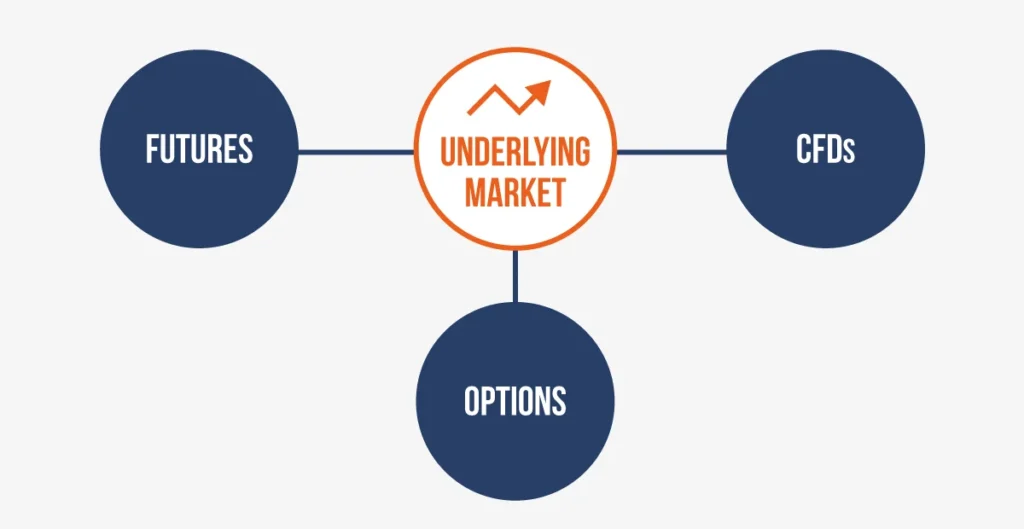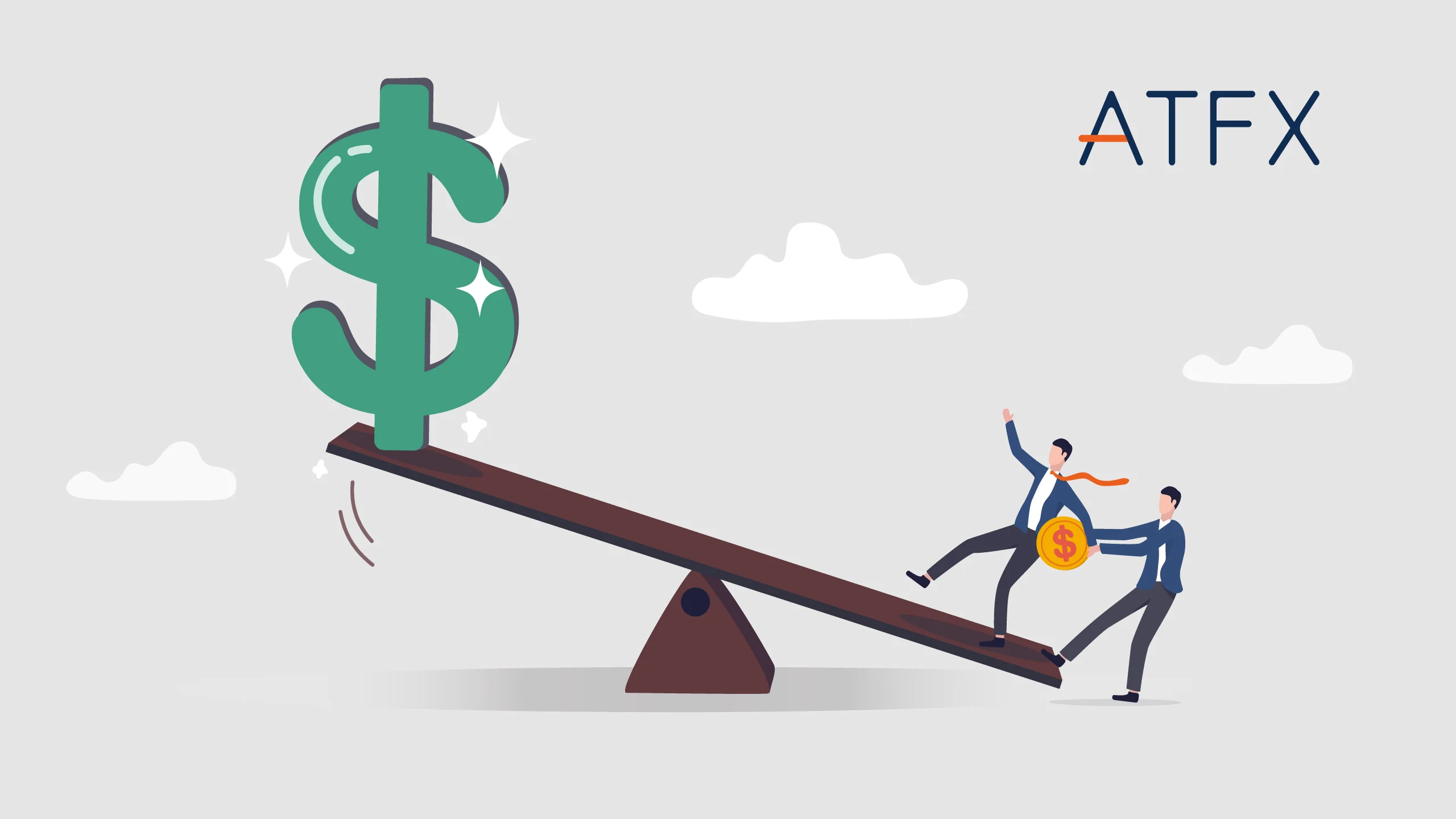Table of contents:
- What is a Derivative?
- Types of Derivatives
- What is Derivatives Trading?
- How Derivatives Trading Works
- Pros & Cons of Derivatives Trading
- Derivatives Trading Strategies
- Conclusion
- How to Trade in the Derivatives Market with ATFX
What is a Derivative?
A derivative is a financial contract in which the underlying asset decides the value. This asset can be anything that changes in value, such as stocks , bonds, commodities , currencies, interest rates, or indices. Derivatives are frequently used to manage or reduce financial risk, speculate on future asset price changes, and increase leverage.
Both institutional and individual investors regularly use derivatives. For example, corporations may use futures to hedge against volatility in raw material costs. Consider an airline that relies significantly on jet fuel; rising fuel prices may diminish its income. To avoid this risk, the airline might sign a fuel derivative contract that guarantees a specific fuel price, allowing it to maintain steady operational costs.
Types of Derivatives
The derivatives market offers a range of contract types, each with distinct features tailored for various uses. Here is a complete analysis of the main categories of derivatives:
Futures: Futures are standardised contracts for buying or selling an asset at a specific price on a future date. These contracts are tightly regulated and traded on markets like the Chicago Mercantile Exchange (CME). A wheat farmer, for example, may use a futures contract to lock in a favourable selling price for the upcoming harvest to protect against future price declines.
Options: Options provide the holder the right (but not the duty) to buy (call option) or sell (put option) an asset at a defined price before the option expires. They can be used for both loss prevention and speculative purposes. If investors predict a stock’s price will rise, they can purchase a call option to benefit without buying the shares.
Swaps: Swaps are agreements that enable the exchange of financial assets or liabilities. The most common type is an interest rate swap, which involves parties exchanging fixed interest payments for variable ones. For example, a firm with a variable-rate loan may enter into a swap agreement to pay fixed interest rates, reducing its exposure to the risks of rising interest rates.
Forwards: Forward contracts, like futures, are agreements to purchase or sell an item at a fixed price at a later date. However, they are more flexible and are traded over-the-counter (OTC). The flexibility to customize these contracts allows the parties involved to adjust the terms. However, this also increases counterparty risk because they are not traded on standard exchanges.
Contracts for Difference (CFDs)
CFDs are derivative products that allow traders to speculate on the price movements of assets such as forex, stocks, commodities (Oil, Gold), or indices..etc without owning the underlying asset. Traders can profit from both rising and falling markets by taking long (buy) or short (sell) positions.
Leverage: CFDs often involve leverage, allowing traders to control a larger position with a smaller capital outlay. While this amplifies potential profits, it also increases the risk of significant losses.
Flexibility: CFDs provide access to a wide range of markets and are traded over the counter, offering greater trading flexibility.
CFDs are popular among traders looking for short-term opportunities and those seeking to hedge their existing portfolios.
Each type of derivative provides unique strategies for managing financial risks, helping traders capitalise on price swings, and discover new investment opportunities.
Learn how to do trading in crude oil futures and options .

What is Derivatives Trading?
Derivatives trading is the purchase and sale of derivatives contracts to hedge risks or benefit from projected price changes in underlying assets. Unlike direct investments in assets like stocks and bonds, derivatives allow traders to profit from price fluctuations without owning the underlying asset.
For example, a derivatives trader betting on crude oil prices may buy oil futures if prices are expected to climb. If oil prices rise, the trader can profitably sell futures contracts. Businesses use futures to control their expenses or profits, hedging against market fluctuations that could hurt their earnings.
How Derivatives Trading Works
The workings of derivatives trading can be complex since they differ based on the derivative and the trader’s goals. Below is a broad outline of how derivatives trading functions:
Contract Creation: The first step is to create or acquire a derivative contract. Exchange-traded derivatives, such as futures and options, contain standard contract terms accessible to everyone with a trading account. Over-the-counter (OTC) derivatives, such as swaps and forwards, are traded privately, each with unique terms.
Leverage and Margin: Traders typically trade derivatives on margin, meaning they must put down a portion of the total contract value to begin the transaction. This leverage allows for huge exposure with a small initial investment, increasing the chances of more significant losses.

Fluctuating Value: The value of a derivative contract fluctuates in response to the underlying asset’s price. For example, the value of a stock option contract fluctuates as the underlying stock price changes.
Settlement: Many derivatives, particularly futures contracts, can be settled (closed out) before their expiration. Specific contracts may require physical delivery of the underlying item at expiration, whilst others need a cash settlement based on the current market price.
The ability to amplify returns and their adaptability gives derivatives their strength, but they also carry significant risks, particularly if the market shifts against a trader’s predictions.
Pros & Cons of Derivatives Trading
Pros
Risk Management and Hedging Options
Derivatives are effective risk management instruments that allow investors to hedge against unfavourable price movements in the underlying assets. For example, a corporation facing foreign currency risk could use currency futures to lock in a favourable exchange rate, reducing the financial impact of future currency fluctuations.
Amplified Returns through Leverage
Traders may control massive holdings with a modest investment by using leverage on derivatives. This enables companies to generate more significant returns from a lower initial investment, allowing them to capitalise on market movements without requiring substantial upfront cash.
Market Access and Diversification
Derivatives provide access to a variety of markets, such as commodities, currencies, interest rates, and equity indices, allowing for diversification beyond traditional stocks and bonds. This diversification decreases investment risk by exposing you to a wide range of asset classes, each of which may react differently to economic conditions.
Enhanced Market Efficiency
The derivatives market is crucial for determining prices, as the prices of derivatives frequently signal anticipated future values of the underlying assets. For example, stock options can reveal the market’s perspective on a stock’s expected volatility, aiding investors in making better-informed choices.
Income Generation through Option Premiums
Selling options (such as covered calls) allow investors to earn an income from the premium received, which can supplement returns and improve overall portfolio performance. This income generation is appropriate in relatively stable markets, where the likelihood of options being exercised is lower, providing a steady cash flow.
Cons
High risk due to leverage
Although leverage can increase your earnings, it also significantly increases the possibility of loss, making derivatives risky for people with no expertise. A slightly negative price movement in a leveraged position can result in significant financial losses, potentially exceeding the initial investment.
Complexity and Knowledge Requirements
Derivatives are complex financial instruments requiring a detailed understanding of the underlying assets, contract terms, and market circumstances. Furthermore, concepts like the “Greeks” of options (which evaluate price reaction to market movements) add complexity that inexperienced traders may find difficult to grasp.
Counterparty Risk in OTC Derivatives
Over-the-counter (OTC) derivatives are privately negotiated, exposing traders to risk if the counterparty fails to meet their contractual obligations. Unlike exchange-traded derivatives, which use intermediaries to reduce risk, OTC derivatives rely on each participant’s creditworthiness, adding another risk layer.
Sensitivity to Market Volatility
Derivatives’ values can vary quickly owing to changes in the underlying asset prices, making them highly vulnerable to market swings. This sensitivity suggests that trading derivatives for speculative purposes could result in large profits or losses quickly, particularly in volatile assets like commodities and currencies.
Derivatives Trading Strategies
Traders use several ways to increase their earnings or reduce their risk exposure in derivatives trading. Here are four popular strategies:
Hedging: Hedging entails utilising derivatives to mitigate potential losses in a primary investment. For example, a coffee vendor expecting price increases may purchase coffee futures to lock in current lower prices and limit cost volatility.
Speculation: Speculative tactics attempt to appropriately forecast swings in asset values and trade derivatives. For example, if a trader believes gold prices will climb, they may buy a call option on gold, allowing them to profit if the price does rise.
Arbitrage: This approach seeks to profit on price differences across related assets or marketplaces by buying a derivative in one market and selling it in another. For example, traders may purchase an investment in one country’s market and sell it for a higher price in another, benefitting from the difference.
Pairs Trading: Investors may maintain opposite positions in two closely linked assets to profit from performance variances. For example, a trader may shorten an airline stock while going long on an oil company, anticipating that changes in oil prices will affect the two businesses differently.
Each approach requires a unique risk management methodology, and knowing these strategies is crucial for successfully navigating the derivatives market.
Conclusion
Derivative trading effectively controls risk, facilitates market exposure, and increases returns. While corporations and institutions use them widely, derivatives also appeal to individual traders seeking advanced strategies. However, investing in derivatives trading carries significant risks, most notably the possibility of sustaining magnified losses. Individuals new to trading derivatives must first gather information and carefully establish their methods to achieve both success and safety in their trading attempts.
How to Trade in the Derivatives Market with ATFX
ATFX is a global trading platform that offers a variety of derivatives trading options, including contracts for difference (CFDs) on many assets. This is a step-by-step instruction on how to trade derivatives using ATFX.
Create an account: Begin by creating an account with ATFX, which is a simple process that requires you to provide some personal and financial information.
Fund Your Account: To deposit money into your trading account, select one of the multiple payment methods. ATFX has a low minimum deposit requirement, making it accessible to traders with various cash levels.
Choose Your Derivative: ATFX offers CFDs on a wide range of asset classes, including stocks, commodities, indices, and forex. The platform provides extensive market information and analytical tools to help users choose suitable derivatives.
Analyse the Market: ATFX provides research tools and technical indicators that help traders analyse asset performance. Leverage these instruments to guide your trading choices in every market condition.
Place Your Trade: Once you finish your analysis, you can specify the position size you want to trade and establish stop-loss and take-profit orders to control your risk exposure.
Monitor and Adjust: Continuously assess your positions on ATFX’s intuitive platform, adjusting them as needed in response to shifts in market conditions.
Close Position: You can close your trade anytime to realise profits or to limit losses. ATFX offers precise and efficient options for trade settlement, including cash settlements.
ATFX combines ease of access with advanced features, making it a top choice for traders seeking to enter the derivatives market with the support of professional tools and a responsive platform.





